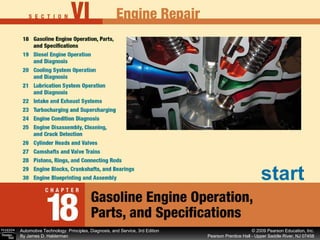
Chapter 18
- 1. start
- 8. Figure 18–1 The rotating assembly for a V-8 engine that has eight pistons and connecting rods and one crankshaft.
- 11. Figure 18–3 The coolant temperature is controlled by the thermostat which opens and allows coolant to flow to the radiator when the temperature reaches the rating temperature of the thermostat. The coolant picks up heat from the engine and after the thermostat opens, the water pump circulates the coolant through the radiator where the excess heat is released to the outside air, cooling the coolant. Coolant is continuously circulated through the cooling system and the temperature is controlled by the thermostat.
- 27. Figure 18–13 A dual overhead camshaft (DOHC) V-8 engine with part of the cam cover cut away. NOTE: A V-type engine uses two banks or rows of cylinders. An SOHC design therefore uses two camshafts, but only one camshaft per bank (row) of cylinders. A DOHC V-6, has four camshafts, two for each bank.
- 37. ENGINE SIZE CONVERSION CHART Liters to Cubic Inches See the complete chart on Page 146 of your textbook.
- 38. Most engine sizes are currently identified by displacement in liters. However, not all 3.8-liter engines are the same. Examples: All 3.8 Liter Engines Are Not the Same! The exact conversion from liters (or cubic centimeters) to cubic inches is 231.9 cubic inches. Due to rounding of cubic-inch displacement and cubic-centimeter volume, several entirely different engines can be marketed with the same liter designation. To reduce confusion and possibility of ordering incorrect parts, the VIN should be noted for the vehicle being serviced. Since 1980, the engine identification number or letter is usually the eighth digit or letter from the left. Smaller, 4-cylinder engines can also cause confusion because manufacturers use engines from both overseas and domestic manufacturers. Always refer to service manual information to be assured of correct engine identification. Chevrolet-built Buick-built Ford-built 3.8-L, V-6 229 cu. in. 3.8-L, V-6 (also called 3,800 cc) 231 cu. in. 3.8-L, V-6 232 cu. in. Engine Displacement
- 40. COMPRESSION EFFECT CHART See the chart on Page 147 of your textbook.
- 46. A good, efficient engine is able to produce a lot of power from little displacement. A common rule of thumb is that an engine is efficient if it can produce 1 horsepower per cubic inch of displacement. Many engines today are capable of this feat, such as the following: Quick and Easy Engine Efficiency Check Ford Chevrolet Chrysler Acura 4.6-L V-8 (281 cu. in.) — 305 hp 3.4-L V-6 (207 cu. in.) — 210 hp 3.5-L V-6 (214 cu. in.) — 214 hp 3.2-L V-6 (195 cu. in.) — 270 hp Mfg Displacement HP An engine is very powerful for its size if it can produce 100 hp per liter. This efficiency goal is harder to accomplish. Most factory stock engines that can achieve this feat are supercharged or turbocharged.
- 48. end